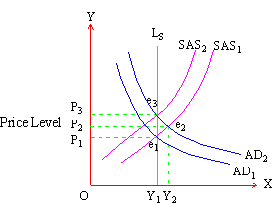|
This is however not a full employment equilibrium. Since Y2 is a long run full employment and output level, there is still some labor unemployed at Y1. Now one is faced with the problem of how to overcome this amount of unemployment. The classical writers assert that if price level is lowered and if wage rates are cut the cost of production will reduce. Employers will be induced to invest more and employ the workers who are unemployed. This will bring about a downward shift in the aggregate supply curve which will now be SAS2. The new supply curve intersects AD1 at point e3. This equilibrium point is on the long run supply curve and therefore ensures full employment. In this equilibrium position output level is Y2 and price level is P3. It has become possible to attain the condition of full employment without any government spending, simply by cutting wage rate. This is the classical solution.
Keynes rejects this proposition. For him such an equilibrium is unattainable. Laborers, with the backing of their trade unions, will not accept a cut in wages. The wage rates are downward sticky or rigid. Therefore the supply curve cannot shift downwards. Yet unemployment can be cured. The only requirement here is to make adjustments on the demand side. If the government undertakes fiscal policy and increases public spending, effective demand will increase. This will cause aggregate demand curve to shift upwards as AD2. The new demand curve intersects both the old supply curve SAS1 as well as the long run supply curve at point e2. Therefore this is the full employment equilibrium. At this point output and employment levels are Y2 and price level is P2. Therefore though the price level P2 is somewhat higher, the problem of unemployment has been solved immediately.
ii. During Inflation: Keynesian expansionary policy helps to overcome the problem of unemployment with an upward shift in the effective demand level. Similarly, his contractionary policy can be used to mitigate an inflationary rise in the price level. In this case what is needed is a downward shift in the effective demand and a reduction in public spending. This has been shown in figure 25.

Figure 25
Level of Real Income and Employment
The levels of income are shown on the horizontal and that of price are shown on the vertical axis. AD1 and AD2 are the two demand curves while SAS1 and SAS2 are two supply curves. The only change this time is an upward shift of the supply curve in the form of SAS2. The initial full employment equilibrium occurs at point e1 with Y1 as the level of income and P1 as the price level. The point e1 is the point of intersection between AD1 and SAS1. If now aggregate demand increases and shifts upward as AD2 then a new equilibrium position is established at e2. This is the point of intersection between AD2 and SAS1. At this point, the level of income is Y2 and the price level is P2. Both income and prices appear to have risen because of the shift in the demand curve. However, increase of income (Y1 to Y2) is purely nominal or monetary in form. Since level Y1 represents the full employment output level, there are no further resources to be employed. Hence there cannot be any real additions to the output (or real income) and income. Again e2 point of equilibrium is not stable. Due to the rising price level, workers and other resource owners will demand a rise in wages and remuneration. With this kind of an increase in the cost of production, the supply curve will shift upwards as SAS2. The new supply curve SAS2 intersects the new demand curve AD2 at point e3, establishing a fresh equilibrium position. At e3 the income level has fallen back to full employment level Y1. But the price level has sharply risen to P3. The point e3 is a stable equilibrium point since it is on the long run full employment supply curve LS Y1. But at e3 the net inflationary rise in the price level is P1 to P3. If the inflation is to be removed and price level is to be restored as P1 then the effective demand will have to be contracted. With a fall in public expenditure, the aggregate demand curve will shift down from AD2 to AD1. The economy will then revert to the old equilibrium point e1. Thus the contractionary policy of reducing public expenditure is helpful during periods of inflation.
|
Index 7.1 Fiscal Policy
7.2
Banking
Chapter 8
|